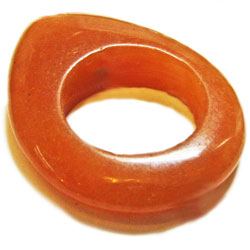

Carnelian is an ancient gemstone and the red/orange variety of chalcedony (microcrystalline quartz). The use of carnelian dates back to approximately 1800 BC. It was used widely during Roman times to make engraved stones for signet or seal rings because hot wax does not stick to carnelian, thus making it an excellent stone for imprinting a seal with wax on correspondence. Egyptians also used carnelian stones in amulets for the stone’s protective role against black magic or the evil eye.
Being a chalcedony gemstone, carnelian can have its classification in common with other chalcedony gemstones. For example, banded carnelian is also classified as an agate as well as a carnelian. Another example is sard, which is very similar to carnelian in color. The terms sard and carnelian are often used interchangeably, though sard is harder and more brownish than carnelian.
| Chemical Formula | SiO2 | Mineral Class | Chalcedony (Microcrystalline Quartz) |
|---|---|---|---|
| Color | Red, Orange | ||
| Crystal System | Hexagonal | Hardness | 7 |
| Transparency | Transparent to nearly opaque | Luster | Vitreous |
| Refractory Index | 1.544 - 1.553 | Double Refraction | 0.009 |
The carnelian crystal is known as a warm, vibrant stone that boosts confidence and the power of true expression and is also known as an artist's stone.
Healers in the Middle-Ages believed in carnelian crystal healing properties and used it to help ease tension and stress.
Carnelian was considered important among the Hebrews and Arabs to prevent illness. The Hebrews believed it kept them from dangers of the plague, while the Arabs employed it as an agent to stop bleeding.
John Schroder declared in 1669 that carnelian powder was good to drink against all fluxes, and when carried it made cheerful minds, expelled fear, created courage and protected against all poisons.
Believed to be a stone of motivation and endurance, leadership and courage, carnelians have protected and inspired throughout history.
Carnelian is also believed to have bold energy that brings a rush of warmth and joy.
Carnelian is traditionally known to guard against falling masonry and accidents with tools. Today it is believed to guard the home from theft, fire, storm or accident.
Carnelian is also believed to lend courage to help overcome difficulties and defend a cause. In addition it is believed to promote idealism, a sense of community, and pragmatism.
Carnelian was believed to give the wearer courage in battle in ancient times and to help timid speakers become both eloquent and bold.
In ancient Egypt, carnelian was thought to be the stone of form and design worn by master architects to show their rank of builder.
Ancient warriors wore carnelian around their neck for courage and physical power to conquer their enemies.
Alchemists of the Middle-Ages used carnelian as a boiling stone believing it to activate the energy of other chalcedonies to transform their energy into useful form.
A talisman for success, carnelian is said to attract prosperity, new resources and good luck in any money-making venture.
Considered both protective and lucky, Roman carnelian rings, or seals, were engraved with deity images or fierce animals.
Carnelian crystals represent the hot cauldron of the lower three chakras. It's associated with taking bold action with its hot and fiery spirit that stimulates the root chakra, helping circulate vital energy to your center, which contains your deepest sexual desires and powerful creative instincts.